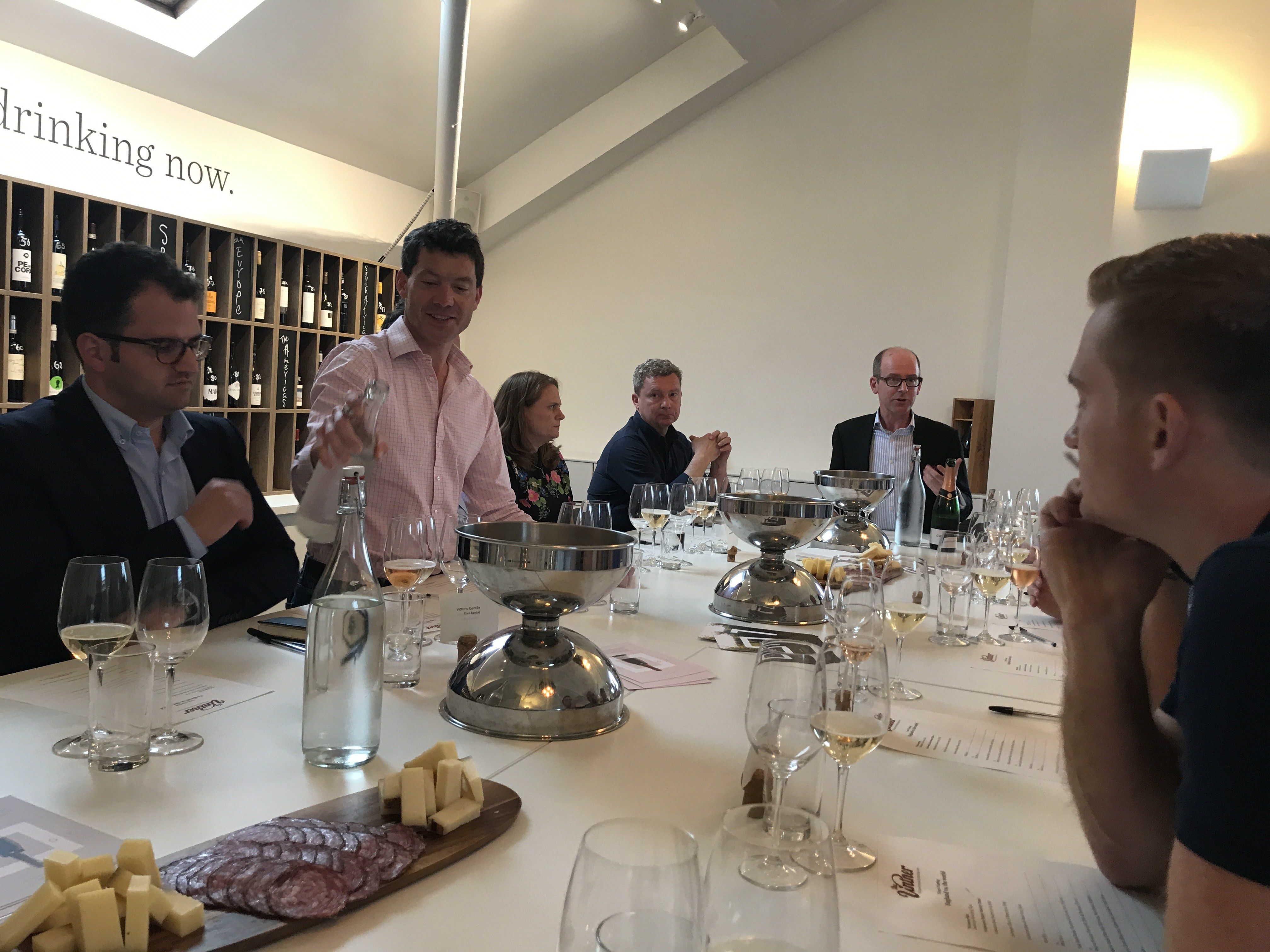The quality and success of English sparkling wines means it is almost guaranteed a hearing for a place on any discerning wine list. But the challenge is harder for still wines. The Vintner and The Buyer put English wine through its paces with a panel of leading on-trade buyers.
There are times when the best thing about working in the wine trade is not necessarily the wines themselves, but the people who make, buy and sell them.
It is the “trade” bit that ties this wider industry together. Sometimes the best and most illuminating occasions in wine are not the big set piece tastings that come with great fanfare, but the smaller, more off the cuff affairs that really give people the chance to talk, relax and get in to the wines on show.
This was very much the approach taken by The Vintner when it teamed up with The Buyer recently to host a relaxed tasting looking at how English wine compared to some of its peers and counterparts around the world.
We have all read and experienced to some extent how well English wine, particularly sparkling, believes it can start to take on all comers, but the proof is ultimately in the tasting.
Up for debate
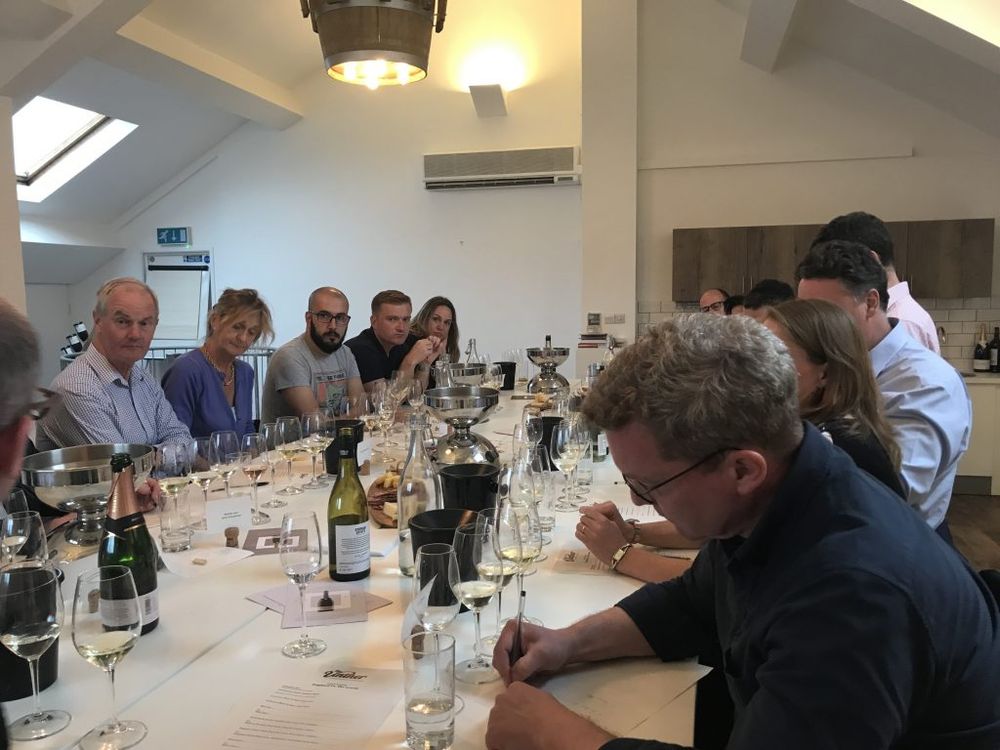
The Vintner tasting included leading on-trade wine buyers and private customers
To help us see how a line-up of English wines and sparklers did against wines from other countries was a select few buyers and guests from the trade.
Namely Harry Crowther, wine store manager for M Restaurants, Ignacio Campos of Hawksmoor, who is currently helping to manage its new Borough Market outlet, restaurant wine consultant, Martin Lam, Thor Gudmundsson, co-founder of The Wine Rooms and Vittorio Gentile, head sommelier at Theo Randall at the Inter-Continental.
The host with the most was The Vintner’s founder Tom Gilbey, helped by head of marketing, James Bidgood, and wine buyer, Charlie Stein. The event was held in the dramatic tasting room in the loft of The Vintner’s mews office next to Parsons Green.
Gilbey said The Vintner was keen to get behind English wine, but there was still a lot of difference in quality out there.
“We tasted 130 different white English wines to get an idea of what is going in the market. So we have learnt a great deal about what is out there,” he explained.
Need for consistency

The Wine Rooms’ Thor Gudmundsson says English wines need to improve their consistency
He questioned whether there was a consistent enough message from the industry as a whole about what it is trying to achieve. He wondered whether benchmark quality levels, similar to what we see in France, might help calibrate the offer and make it easier for buyers and consumers to know what they are getting.
“Let’s organise ourselves better and see more collaboration going on. That’s what the industry needs,” he stressed.
Gudmundsson said there was no doubting the quality of English sparkling wine now in the market. But the issue for him about English wine in general comes down to consistency. “You just don’t know what you are going to get.”
“There are also still too many German varieties being used that commercially customer just don’t understand,” he added.
For Campos the issue was more about the prices being asked for some English wines, particularly still, that he believes just don’t have the “complexity” to warrant them. Particularly considering the choice and alternatives available from the rest of the world.
Gilbey agreed that “still English wines were certainly a much harder sell than sparkling”.
“People are seeing the experience you can get with English sparkling wine, which they are just not getting with still,” added Lam.
One voice needed
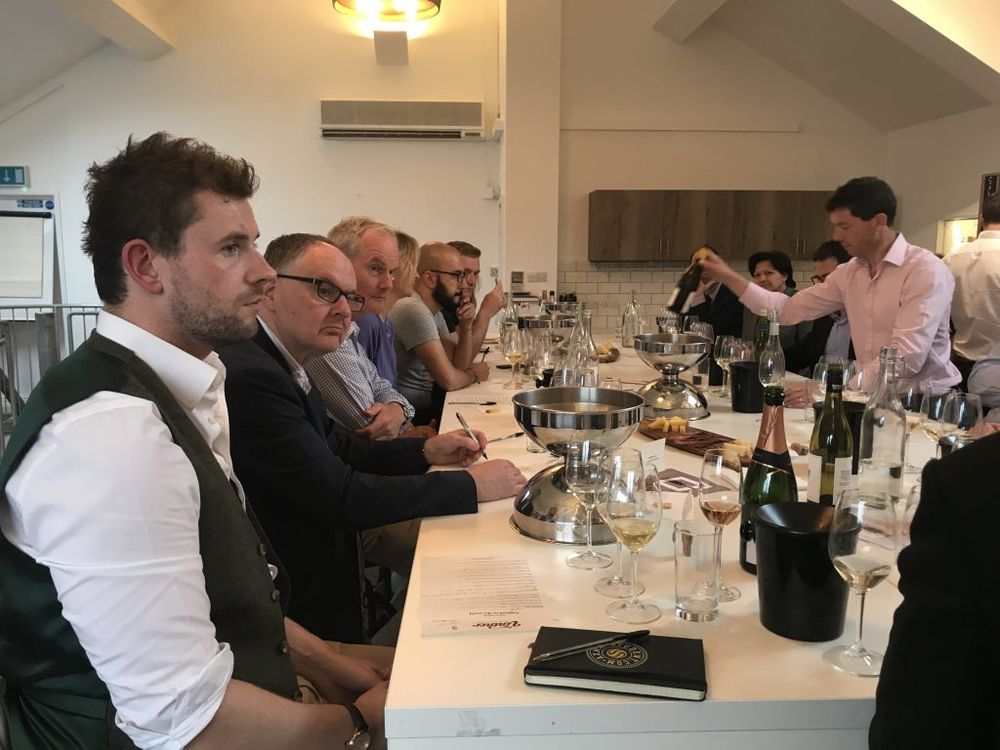
Harry Crowther from M Restaurants and Martin Lam were both interested in how Champagne houses are now taking English wine seriously
It is certainly, agreed the panel, a long way from how co-ordinated and focused the Champagne houses are in speaking in one voice, with one powerful message about the quality of its wines.
An issue that was picked up by Crowther at M Restaurant who pointed to the enormous UK national press coverage that Champagne Taittinger has got for planting vines in its newly acquired vineyard in Kent (alongside Hatch Mansfield).
Lam even foresaw a time when Champagne houses were actually taking market share away from English wine producers.
Gilbey added: “Wouldn’t it be great the next time James Bond presses a button to release a bottle of Champagne it is actually a bottle of English sparkling wine that comes out.”
Which was why Gilbey and The Vintner was so keen to host an event that also gave key on-trade buyers the chance to taste across what it hopes was a good demonstration of the kind of quality English wine styles available to buy.
Gusbourne sets the scene
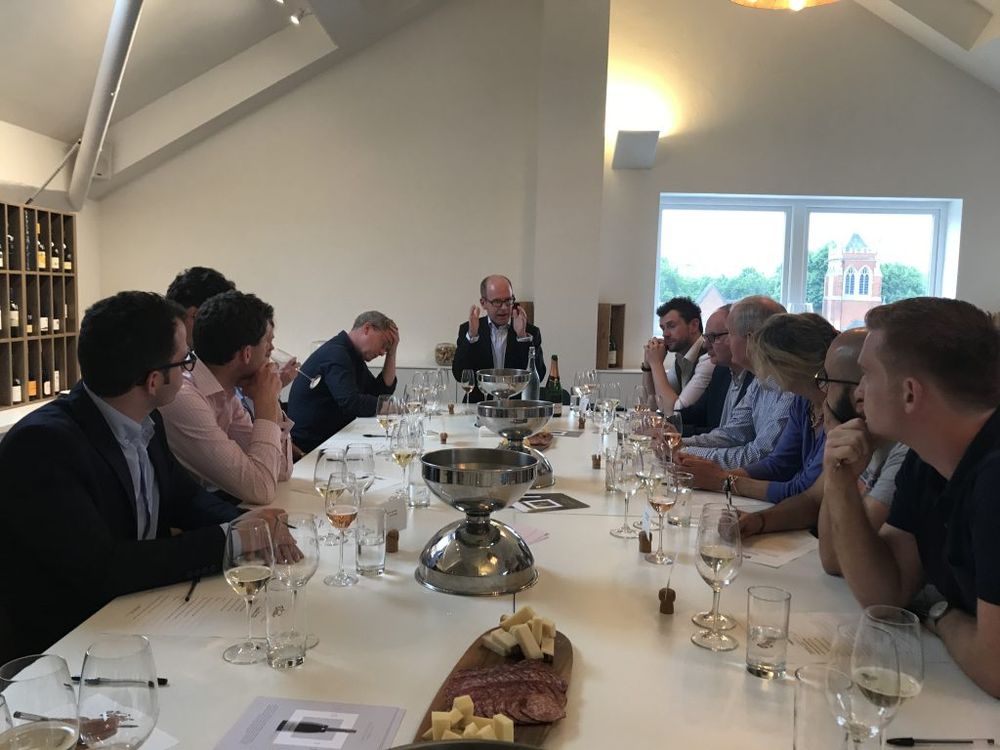
Gusbourne’s Neil Irvine leads the panel on a tasting of its wines
To help set the scene, and hopefully provide a benchmark for quality English wine, was Neil Irvine, commercial manager for Gusbourne in Appledore, Ashford, Kent.
For him the big change in English wine in recent years has been the confidence to really start making wines that are true to this country. For years there had been too many envious glances across the Channel to see, quite understandably, how the Champagne houses do things.
“We want people to see us for what we can do. What are unique characteristics are, and not compare us to anyone else,” he explained.
The results are not only being seen in the amount of awards that English wine is now winning, but the fact wineries, such as Gusbourne, are now making wines such as its 100% Pinot Noir rosé, said Irvine.
That wine (a 2013 vintage) is a great case in point, he added, because it used a Burgundian clone of Pinot Noir and planted it in clay fossil compound soils. “We wanted to put something different in to different soils and see what happened.”
It was fascinating tasting through many of Gusbourne’s wines including its Gusbourne Brut Reserve 2013; Blanc de Blanc 2012; and Guinevere Chardonnay 2013.
Those with long enough memories of the English wine scene will remember the 2012 vintage was a bit of a “car crash” as Irvine delicately put it. A year when only around a million bottles rather than its normal five or six million was made.
Gusbourne was one that was still able to produce quality wine, and its Blanc de Blanc signature style stood out in this mini tasting. This is very much the biscuity, packed with crunchy acidity, with four years aged on lees, that is now the backbone of the English wine industry. A wine that Gusbourne is able to make from vines that date back to 2004.
The panel were surprised to find the Gusbourne Guinevere Chardonnay was only 11.5%
Gusbourne was one of the first wave of English wine producers to really look at building up its exports. “We actually found it easier to sell our wines in the US and Australia than here,” he said.
England vs…
With the mini Gusbourne master class under their belts our panel of tasters was then asked to rate English wines against some of their global competitors.
First up there was little to choose or even contrast between Nyetimber Classic Cuvée NV vs Louis Roederer Brut Premier NV. Whether it was Nyetimber’s intention to get as close to a Champagne or not they certainly complemented each other.
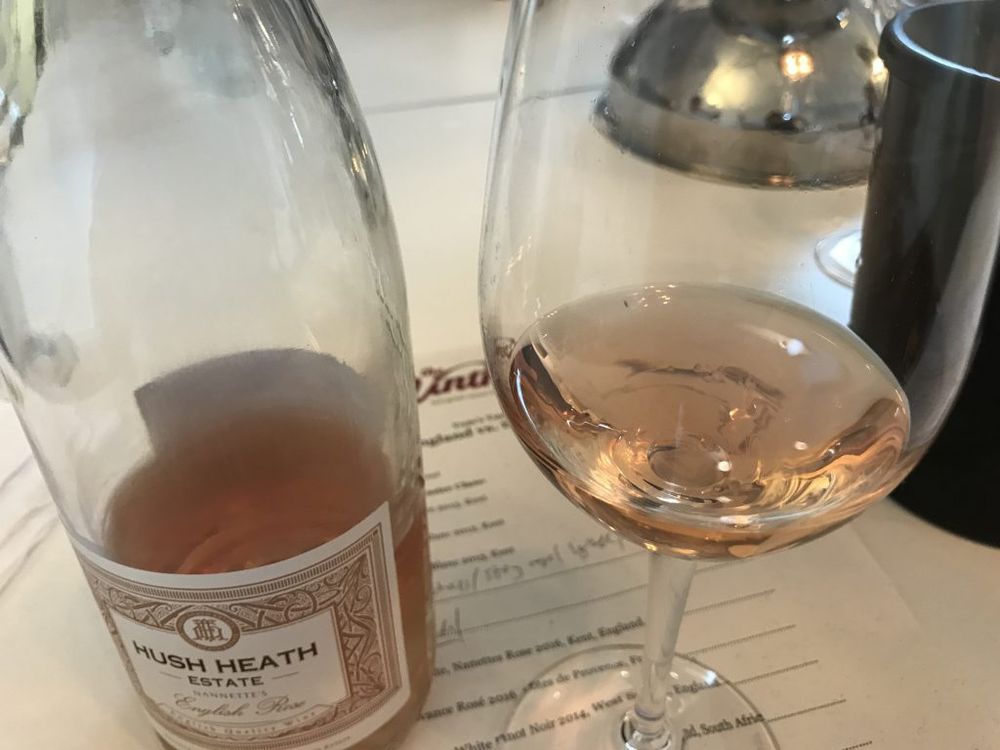
The style and colour of rosé that consumers just love, said the panel
Gilbey was happy to big up the Hush Heath’s Nannettes Rosé 2016 in the second match up with Made en Provence 2016, France.
“We have tasted a lot of rosés and we think this is just very good. Particularly when you think it retails at around £15,” he said. “If it’s the right colour then people will pay proper money for rosé. It is flying this summer.”
Of the two the buyer’s panel thought the Hush Heath was best suited to food, thanks to its slightly higher residual sugar level. “It’s a fruitier, richer style of rosé compared to the classic, drier Provence style,” said Gilbey.
Up against Swartland
Next up was a battle of left field producers and wine with an unusual Kingscote White Pinot Noir 2014 from Sussex vs AA Badenhorst’sSecateurs Chenin Blanc 2016 from Swartland in South Africa.
“It’s very unusual to find white Pinot Noir, never mind from England,” said Lam.
The pairing not surprisingly split the panel. Ignacios agreed the high acidity in the Kingscote Pinot Noir meant it would be a good food friendly wine rather than a wine to drink on its own. Gudmundsson thought it would be better suited to Asian and spicy food with its raised sugar levels.
Next up it was a case of putting two Pinot Gris’ to the test with Stopham Estate Pinot Gris 2015, Elgars Reserve, Kent vs Archangel Pinot Gris 2014, Central Otago, New Zealand.
Lam was intrigued by the Archangel and felt the Pinot Gris had Semillon characteristics to it.
Gilbey felt it was typical of Central Otago. “The first wine we imported in 2010 was from New Zealand. This is such a rich, generous wine.”
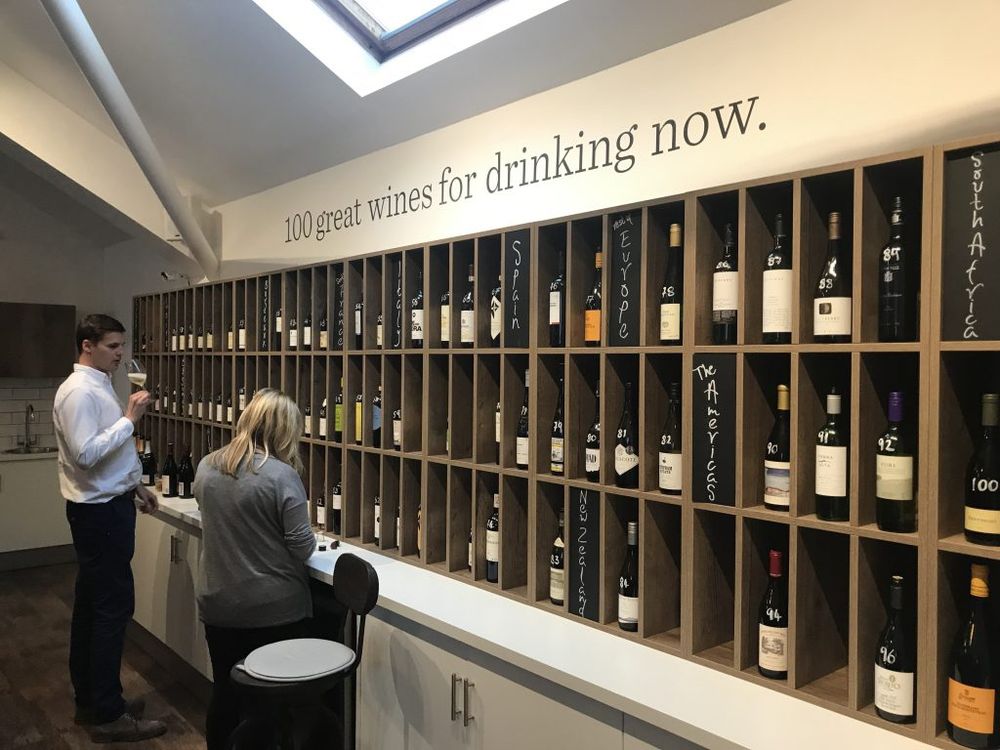
The Vintner’s tasting room is also a showcase for its wine offer – which only ever lists 100 wines suitable for drinking now
He is also very taken by the Stopham Estate Pinot Gris and said it was one of the wines that really stood out when it did its cross industry tasting of English wine.
The final pairing on the night was Hush Heath Estate’s Pinot Noir 2016 vs James Bryant Hill Estate Pinot Noir, from Central Coast California. Considering the growing conditions these were not surprisingly very different styles of wine, but Gilbey was keen to show the lightness and delicate tough that you can find in some English red wines, like this example from Hush Heath.
The panel certainly warmed to Hush Heath but Ignacios felt it did not have the “complexity” he would be looking for at that price point (retail price £19).
Onwards and upwards
Being such a relaxed evening there was no point tallying done. That wasn’t really the point. The Vintner certainly was not looking for an “English wine beats the world” type of headline.
But what it did do is show, if not reinforce, how well English wine is doing in so many areas. Particularly in how it is producing sparkling wine that can certainly compete if not match or do better than its counterparts around the world.
The still wine market is going to be a harder nut to crack, particularly for on-trade buyers looking at where they are going to genuinely place them on a competitive wine list that gives them a chance to be sold.
Here’s to hosting another tasting in a year’s time to see where English wines and on-trade buyers are then.
